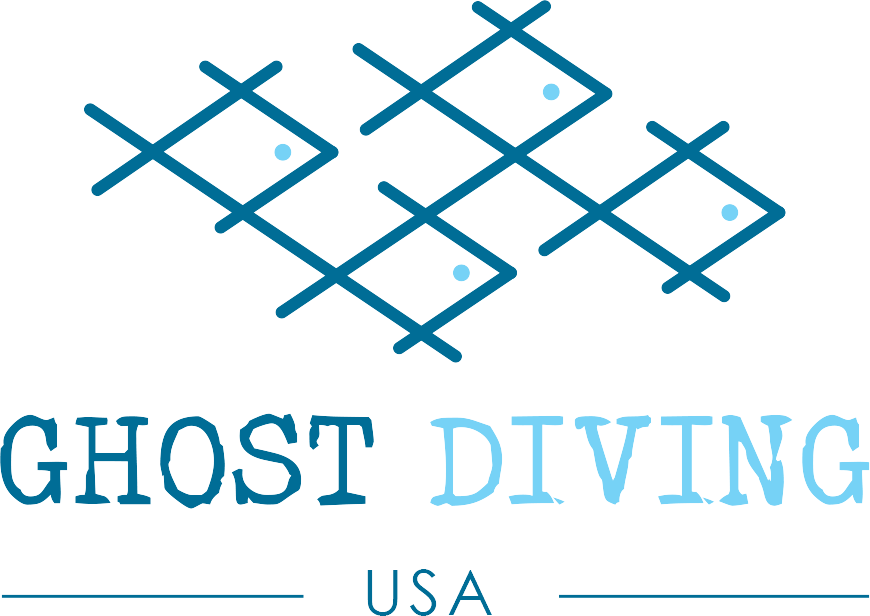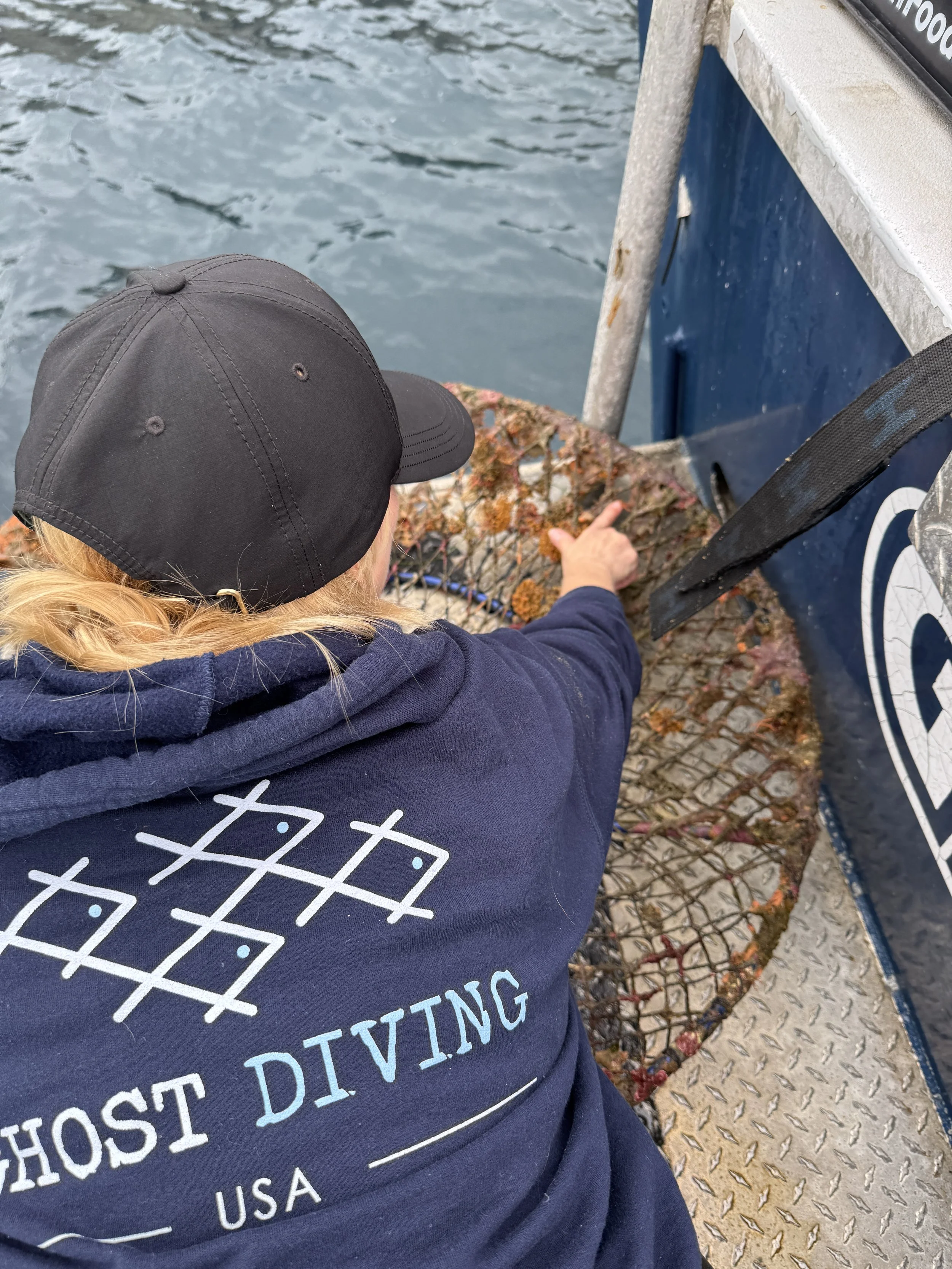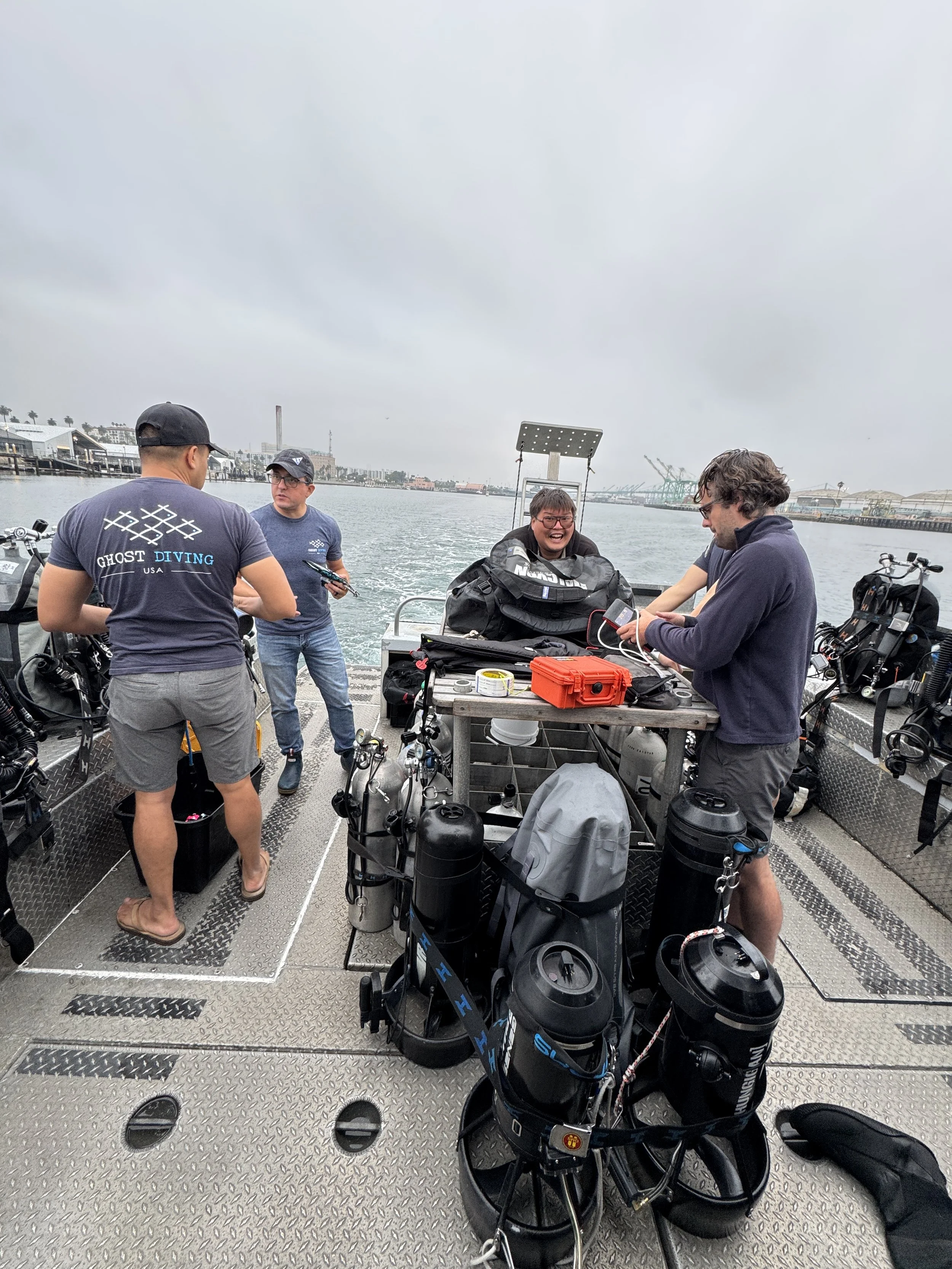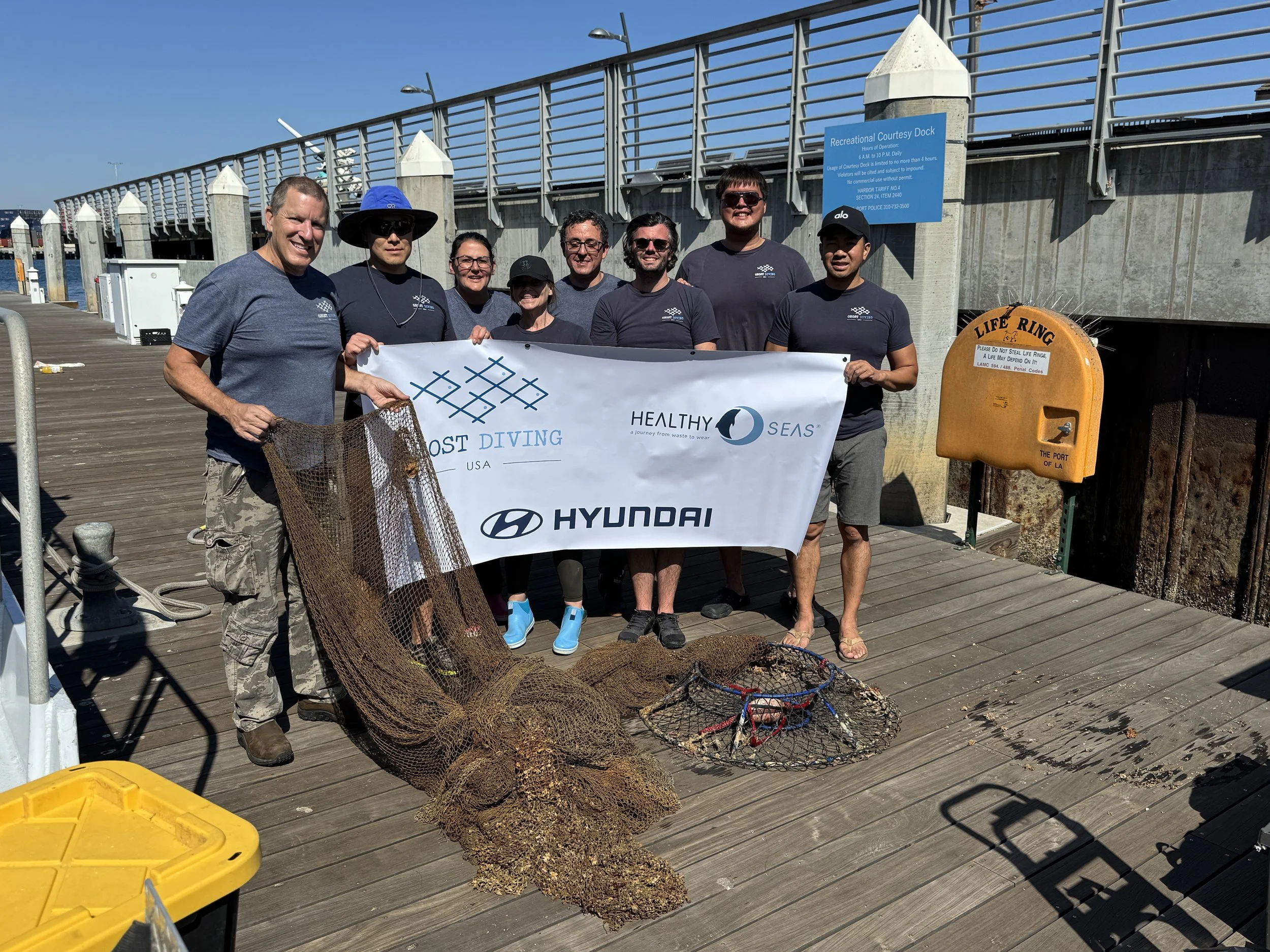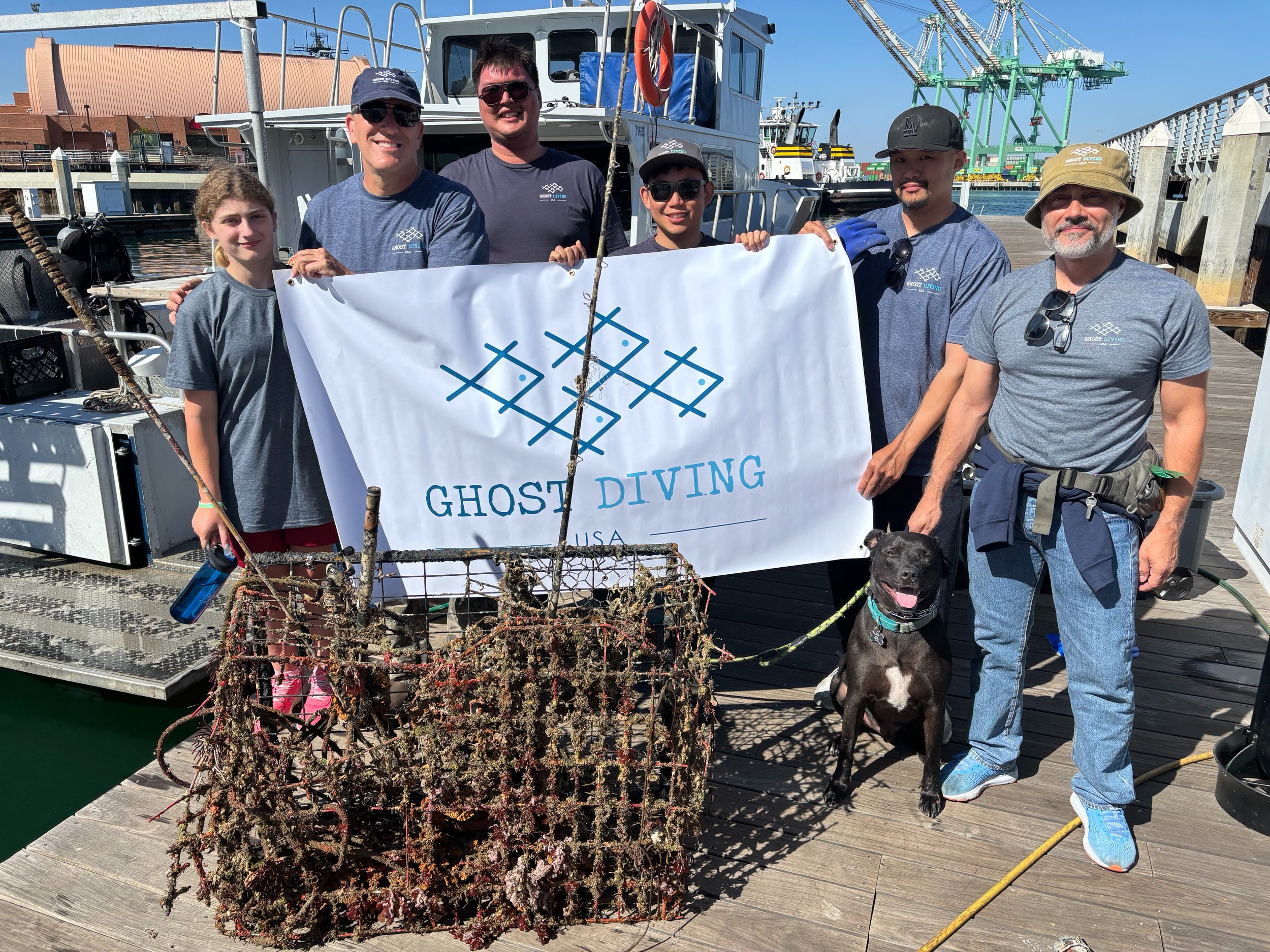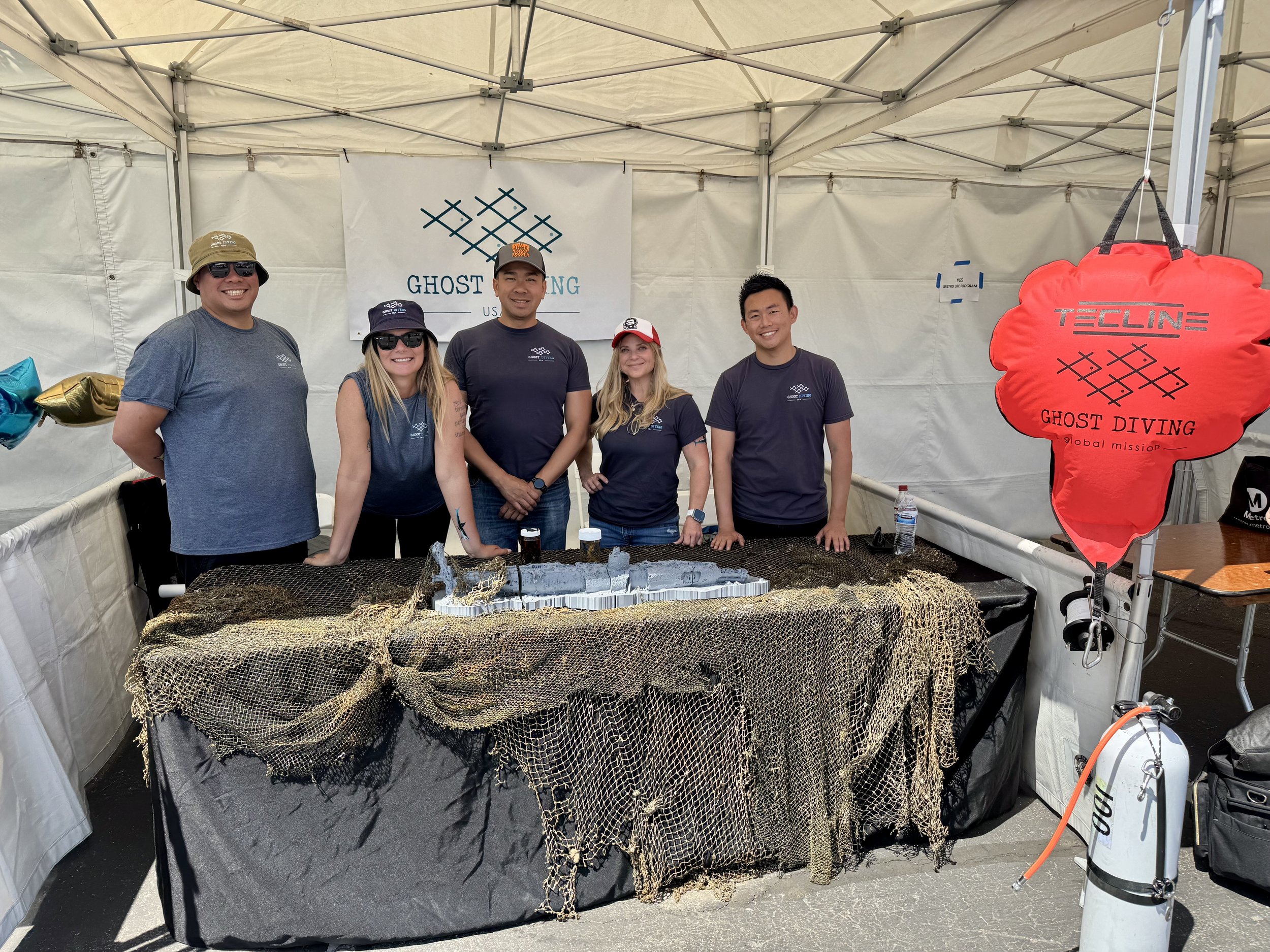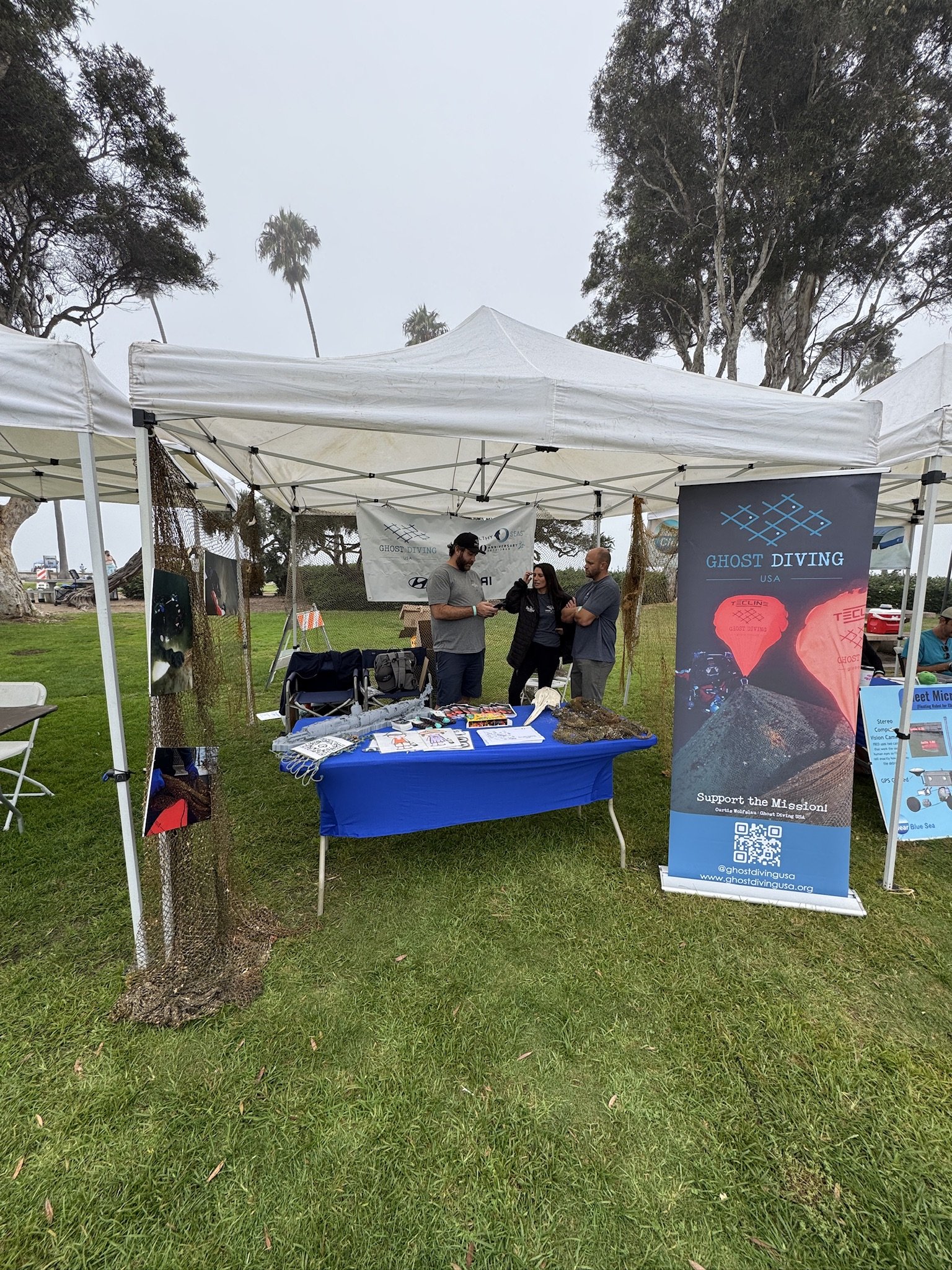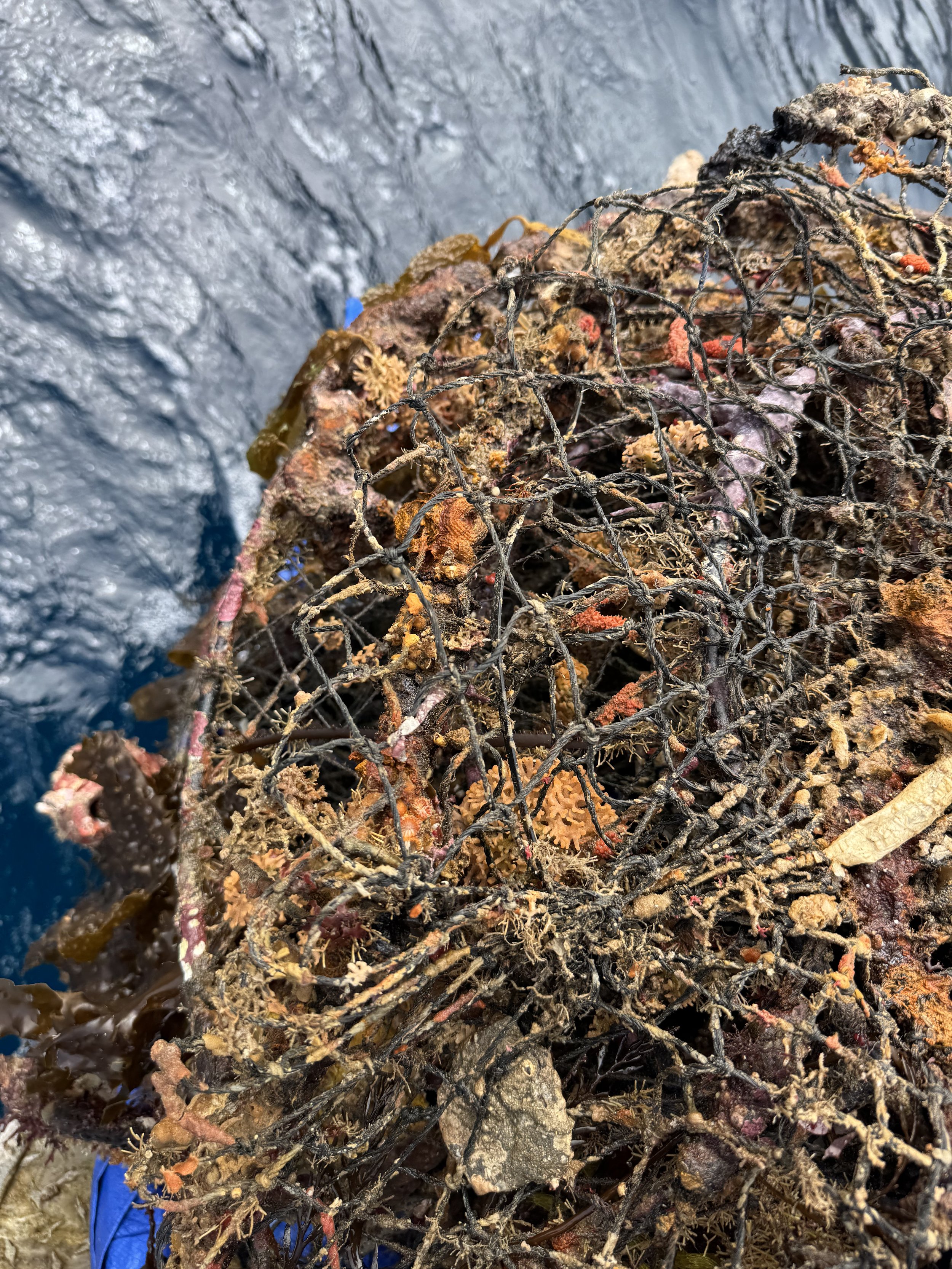Tuna Clipper
Location: Catalina Island
Wreck: Tuna Clipper
Teams:
Team 1: Michael Gasbarro, Andrew Hung
Team 2: Keith Chu, Juan Torres
Team 3: Jim Babor, Tianyi Lu
Surface Support: Laurie Dickson, Katie McWilliams
Mission Impact: 500 square feet of net removed, 1 hoop lobster pot removed.
Team Ghost Diving USA dove back in at the Tuna Clipper to continue our clean up efforts. Divers were met with stunning conditions topside and below.
The teams opted to stagger their profiles to maximize bottom times. Team 1 was tasked with placing lift bags and jumped in first, after approximately 20 minutes team 2 dove in to document, and then finally team 3 was the cut team.
The teams were able to complete their assigned tasks with no challenges and worked collectively to remove 500 square feet of net and 1 lobster pot.
A very straight forward and successful day for the team. The recovered net and lobster pot were taken to a local artist for a project. Stay tuned for details to come!
A very special thank you to our partners at Healthy Seas and Hyundai USA for supporting our clean up efforts.
Laguna Beach
Location: Laguna Beach, California
Site: Crescent Bay, Crystal Cove, and Emerald Bay
Teams:
Team 1: Andrew Hung, Norbert Lee
Team 2: Karim Hamza, Erik Lu
Surface Support: Jim Babor, Emma
Mission Impact: 100 pounds of debris removed.
Every mission serves as a lesson for team Ghost Diving USA. The goal for this mission was to motor down the coastline to Laguna Beach and collect lobster pots reported by two of our team members, Andrew and Norbert.
The team arrived to find that water conditions were quite challenging. There was a large North to South swell that created intense current and very poor visibility. The teams searched the area for the pots. Unfortunately, after a lengthy search, the teams had to call off the search due to poor visibility.
The team opted to move to a second site. Captain Jim of the Giant Stride skillfully anchored on GPS coordinates provided by Andrew and Norbert. The teams re-entered the water. They successfully located a lobster pot, despite the challenging conditions. They were also able to find a pile of fishing debris including fishing rods that Andrew had placed while on a shore dive prior to the mission.
While the dives were challenging, team Ghost Diving USA rose to the occasion and were able to learn valuable lessons as we continue our pursuit of ghost gear.
Tuna Clipper
Location: Catalina Island, California
Wreck/Site: Tuna Clipper
Teams:
Team 1: Jim Babor, Symeon Manias, Terry Koritz
Surface Support: Angie Biggs, Jamie Mitchell, Mark Self
Mission Impact: 300 pounds of net removed.
A small but might team of Ghost Divers set out as part of the World Environment Day of Action Campaign. We headed back to the wreck of the Tuna Clipper to continue our ongoing clean-up of the site.
The plan for the day was to descend, survey the site to check the status of the clean-up effort and, of course, remove more net. As the team descended, they found a large section of net out in the sand. As the team briefly surveyed the wreck, they found that there were multiple animals ensnared by the net. These animals included a cormorant, multiple fish, and a seal that was at an advanced stage of decomposition. The animals were documented.
The team opted to remove the large section of net out in the sand. The team used 5 lift bags to lift the net and were able to send all the net to the surface. They completed their decompression obligation and returned to the boat.
The surface crew, with help from Captain Galvin, were able to get all the net on board. The team was very happy to be part of a global initiative that brings awareness to the needs of our environment and empowers everyone to be part of the solution.
The nets were taken to a local partner to be upcycled into sustainable materials.
UB-88
Location: San Pedro, California
Wreck/Site: UB-88
Teams:
Team 1: Jung Hseih, Norbert Lee
Team 2: Karim Hamza, Nir Maimon
Team 3: Symeon Manias, Curtis Wolfslau
Surface Support: Angie Biggs, Laurie Dickson
Mission Impact: 800 pounds of net removed.
Team Ghost Diving USA returned to the UB-88 wreck to further our clean up of this historic wreck. Teams planned to work most efficiently by staggering their dive times. Team 1, Jung and Norbert, were tasked with setting lift bags, preparing the sections of net to be cut, and begin the net cutting process. Team 2, Karim and Nir, descended as Team 1 began their decompression schedule. They were focused on cutting net in the designated areas prepared by Jung and Norbert. Team 3, Symeon and Curtis, descended with Karim and Nir and documented the net cutting.
Our divers are diligent about checking the nets for trapped sea life. Unfortunately, in checking the nets, we always know that there is a possibility that we will find something that didn’t survive it’s encounter with the nets. Unfortunately, we found a harbor seal. The harbor seal had clearly been ensnared in the net for quite awhile given the state of decay.
While this is sad, documenting these findings is an important part of our work. While we always hope that we do not find something to document, these findings validate why our work is important and must continue.
Cabrillo Marine Aquarium Earth Day
We had the opportunity to return to the Cabrillo Marine Aquarium for their Earth Day event! The event was well attended and included incredible exhibitors including Cal State Long Beach’s Shark Lab, The Jane Goodall Foundation, and the American Cetacean Society, to name a few. The event was well attended and included interactive activities for children including crafts and games. The Aquarium also had various informational sessions throughout the day including about the famous grunion run that was also happening that weekend.
It was a great day to connect with the community and celebrate our home planet!
LA County Sanitation District Earth Day
Team: Angie Biggs, Keith Chu, Laurie Dickson, Jung Hseih, Norbert Lee
Our team was thrilled to return to the LA County Sanitation District’s Earth Day event. We hosted an outreach booth where community members were able to rescue an animal, inflate a lift bag, look at the 3D model of the UB-88, and examine preserved samples of marine life and look at various pictures.
As always, a very special thank yout o our volunteers who make these events possible and do a fantastic job of sharing their experiences and connecting with the community!
Emerald Bay
Location: Laguna Beach, California
Wreck/Site: Emerald Bay
Teams:
Team 1: Andrew Hung and Norbert Lee
Mission Impact: 1 cage style lobster trap located and marked using GPS, additional survey completed.
Our team is truly special because our divers are relentless in their pursuit of marine debris. 2 of our team members, Andrew and Norbert, completed a survey of a local diving hot spot, Emerald Bay. There are a few things that make this site unique. First, it is a shore dive which means that divers gear up at their cars and walk to the entry point with all of their gear. Then, once they get to the beach, they have to walk across the sand (with all the heavy gear!), get into the water through the waves, put their fins on just outside of the break zone (where the waves crash), and then swim to their descent point. In summary: it’s a workout! Laguna Beach is also unique in that the beaches are a series of coves. For divers, this means that you can (theoretically) dive 2 coves or more coves in one dive, assuming you have a diver propulsion vehicle (DPV).
The dive plan for the day was for Andrew and Norbert, using their DPVs, to survey multiple coves for lobster pots and any other debris and collect GPS coordinates using the GPS buoy.
Unfortunately, the conditions did not allow the team to survey multiple coves. However, they were able to locate and mark one lobster pot for future collection.
UB-88
Location: San Pedro, California
Wreck/Site: UB-88
Teams:
Team 1 - Jung Hseih, Norbert Lee
Team 2 - Karim Hamza, Mark Self
Team 3 - Jim Babor, Curtis Wolfslau
Surface Support: Laurie Dickson, Katie McWilliams
Mission Impact: No net collected
Team Ghost Diving USA returned to the UB-88 aboard the Giant Stride. When we concluded our UB-88 project, we found that there was still some net to be cleaned up and there was some steel cable that needed to removed.
Divers, armed with heavy duty bolt cutters, planned to try the cut the cables with the bolt cutters and continue their work removing the remaining nets. We arrived to the site, the anchor dropped and Jung and Norbert geared up to jump in. After getting in, Jung and Norbert noted a strong surface current. They opted to drop below the surface, hoping the current would go away as they got deeper.
Bad news, the current blew them away from the boat in the opposite direction. The team and Captain Jim sprang into action and sent a current line out to them. Jung and Norbert continued to try and get back to the boat using their diver propulsion vehicles aka scooters and kicking. They were not making progress getting back to the boat. They grabbed the current line and the team worked to pull them in. Once they were safely back on board, the team opted to wait for a little bit to see if the current would die down.
Unfortunately, it did not. But, it was a ton of fun to hang out on the boat with the team members and wait. Ultimately, the team opted to cancel the diving for safety reason and headed home.
Until next time, UB-88.
Avalon Harbor Cleanup
Location: Avalon, Catalina Island, California
Dive team: Jim Babor, Angie Biggs, Sean Canullas, Karim Hamza, Andrew Hung, Shane McWilliams, Daniel Pio
Shore team: Alysha Acosta, Katie McWilliams
The Avalon Harbor Cleanup is an annual event in Southern California. The purpose of the event is to raise funds for the USC Catalina Hyperbaric Chamber. The chamber is run by highly trained volunteers. It is the only chamber that stands ready 24 hours a day, 7 days a week, 365 days a year ready to treat injured divers. There is something special about the Avalon Harbor Cleanup. It is the first of 2 fundraisers that support a year of chamber operations. It provides a sense of purpose for participants. It also serves as an annual reunion for the diving community. While Southern California is large, the Southern California diving community does a great job of making it feel smaller and friendlier. This event also gives everyone the opportunity to give back to the island that gives us all so much. Almost everyone has memories of diving the Casino Point Dive Park and a favorite Catalina dive site.
This year Ghost Diving USA had a booth in Avalon during the event and our team supported with heavy item recovery from aboard the Giant Stride. On shore, it was exciting to watch the Giant Stride come into the harbor. It was fun to wave to our friends from the beach.
It was a very busy day for both our shore and dive team. The shore team had the opportunity to connect with other dives and passersby. In talking to the visitors, it was interesting to hear the various experiences with marine debris. Many of the visitors shared about trash they find at their favorite dive sites or the balloons that they see floating on the surface as they make the crossing to Catalina Island.
As sad as it is that we all have experiences with marine debris, it is refreshing and inspiring to connect through a shared passion for cleaning up marine debris.
We had our model of the UB-88 on display. It was great to discuss the success of our UB-88 project. As we talked to people, it was interesting to see how many people were unaware of the UB-88 wreck and its history. It adds a unique texture to the fabric of the history of Southern California wrecks.
The shore team got to say a brief hello to the dive team when they brought a boat battery and other debris to the shore to be counted.
In talking to all of the participants, they had a great time and enjoyed a day that serves to build community and camaraderie.
We look forward to next year!
Whale Fiesta
Location: Cabrillo Marine Aquarium, San Pedro, California.
Team Members: Angie Biggs, Sean Canullas, Laurie Dickson, Michael Gasbarro, Erik Lu, Katie McWilliams, Shane McWilliams
Ghost Diving USA had an exciting opportunity to be an exhibitor at the Cabrillo Marine Aquarium’s Whale Fiesta! The purpose of the event is to educate the community about the incredible whales that can be seen off of the California coast.
Team members were quick to set up the booth and activities for the day. In honor of Whale Fiesta, we prepared a whale craft for the children attending the event in addition to our usual activities.
The day was a ton of fun! Our booth was next to a table of whale baleens and bones and across from an inflatable humpback whale. Everyone that we spoke to at the event was very excited to talk to us and ask questions about our work. They were surprised to hear about the prevalence of the problem. It was a great day to connect with the community, create art, and enjoy an incredible aquarium. We look forward to next year!
Special thank you to Erik Lu for this video of the day!
Project: UB-88
Project UB-88 has finally come! There is excitement and anticipation circulating amongst the team. Years of training, commitment, hard work, and fun dives have lead our divers to this mission. A year of preparation has lead the team to this moment. This mission was so big it required 2 boats and a minimum of 3 surface support personnel each day. UB-88 brings a unique challenge. She sits in 200 feet of seawater in the mouth of the San Pedro Harbor. This dive is a deep technical dive and requires a high level of training and experience. In addition to the challenge presented by the depth of the wreck, it sits in the middle of an active shipping channel. When you are anchored by the UB-88, you can see the Catalina Express zip across the channel, large freighters waiting to enter the port, and various smaller vessels coming and going like cars on a highway. This presents a unique challenge for divers for several reasons. First, being in the middle of the channel, there’s no structure to protect the area from conditions such as currents or swells. Next, if divers surface away from the wreck or away from the dive boat, there are several safety concerns. Larger vessels can’t see them, if the current is strong they may need assistance getting back to the boat, or they can become disoriented and struggle to find the dive boat because of conditions below the surface. For all of these reasons, we give a very special thanks to Captain Jim Simmerman of the Giant Stride and Captain Kevin Bell of the Bottom Scratcher and their crews for working collaboratively with our surface support crews, and ensuring the safety of our divers.
Day 1 - 12/16/2024
Divers:
Net handling divers: Jim Babor, Michael Gasbarro, Karim Hamza, Norbert Lee, Symeon Manias, David Watson, Curtis Wolfslau
Safety divers: Shane McWilliams, Daniel Pio
Surface support: Angie Biggs, Jamie Mitchell, Katie Papac
Surface documentation: Kian Farin
The objectives for day 1 were to complete an assessment of the net to ensure it matched our notes from the last survey and place lift bags. Norbert, Director of Scientific Studies, focused on taking baseline data for his study that examines the impact of the net on the wildlife that lives around the wreck.
Day 1 was a success! Given the logistical requirements of the divers due to the depth, the volume of net, and the significant attention to detail required for this site, the divers placing lift bags and updating survey notes is a significant step. By updating survey notes, divers can give the Day 2 teams a thorough and accurate briefing for the next day. By placing the lift bags the teams are able to return and start cutting the nets.
Day 2 - 12/17/2024
Divers:
Net handling divers: Jim Babor, Michael Gasbarro, Karim Hamza, Norbert Lee, Mark Self, David Watson, Curtis Wolfslau
Safety divers: Jamie Mitchell, Rene Tetter
Surface support: Angie Biggs, Shane McWilliams, Katie Papac
Surface documentation: Kian Farin, Zachary Rich
Day 2 came with new objectives. These objectives included rehoming some metridiums (a type of anemone) off of the net and to a safe area for them to grow, the placing of more lift bags, and teams were to begin cutting nets.
Day 2 was a success! Divers were able to remove approximately 500 pounds of net! More excitingly, they were able to save some fish and crabs that were trapped in the nets in the sand. Divers left some lift bags for the Day 3 teams to allow for efficient workflow the following day.
A very special thank you to Leanne Suter of ABC 7 News who ran a story about the project that aired today. You can find the story here.
Day 3 - 12/18/2024
Divers:
Net handling divers: Jim Babor, Michael Gasbarro, Karim Hamza, Norbert Lee, Tianyi Lu, Symeon Manias, Curtis Wolfslau
Safety divers: Shane McWilliams, Daniel Pio
Surface support: Angie Biggs, Laurie Dickson, Jamie Mitchell, Juan Torres
Day 3, half way through the project! The goal today was to clear the torpedo tube of all the of the nets that are entangled on it. In doing this, the wreck of the UB-88 will be free of the nets that have haunted her. There will still be nets in the sand surrounding the net but this will be a significant and exciting accomplishment for the team if they are able to meet the objective.
Our team not only met the objective, they absolutely smashed it! Not only did the team free the UB-88 of the nets, the team was able to remove 1,500 pounds of net!
This is significant for a number of reasons. First, this is 1,500 pounds of net that can no longer ensnare and kill marine life. Next, the net will no longer have the opportunity to destroy the artificial reef the UB-88 has become. Finally, this is the largest net haul in GDUSA history!
Well done to the team! A special shout out to the surface support and safety diving teams that worked together to secure the 1,500 pounds of net to the Giant Stride!
Day 4 - 12/19/2024
Divers:
Net handling divers: Jim Babor, Kian Farin, Jung Hseih, Norbert Lee, Tianyi Lu, Symeon Manias, David Watson
Safety divers: Jamie Mitchell, Rene Tetter
Surface support: Angie Biggs, Laurie Dickson, Shane McWilliams
Special guests: Courtney Griffith (conservation artist), Erin Stone (journalist, LAist)
Day 4 finds our team excited to dive back in after a massively successful Day 3! Today’s objectives include a final survey and cleaning of the torpedo tube and address any additional pieces of net that could actively fish. The next objective is to evaluate the net that is in the sand and what will need to be done to remove it. Then, there are steel cables that the team needs to evaluate and determine what they need to do to appropriately remove the cables.
Another successful day for the team! They were able to get the net in the sand collected into one area which will facilitate efficient removal. The team does still need to find the correct tool to address the steel cables but they were able to gather good information to support an informed decision about strategies. There was a hint of disappointment when the team realized and accepted that the clean up will not be completed in 5 days. Rather than being upset or chalking it up as a loss, the team walked away happy to have made a significant dent in major project.
A very special thank you to our special guests Courtney and Erin. By spreading the word about our work and why it matters, you not only support GDUSA, but you empower the community to choose the health of the ocean.
Courtney is a conservation artist that uses marine debris to discuss conservation and the human connection to the environment. From the net she was given, she created an installation called Cruel Immorality. You can learn more about it and the rest of Courtney’s work here.
Erin is a Climate Emergency Reporter with LAist. Erin’s passion lies in educating the public about the shifting climate and helping the public to understand how and why this shift is happening. Erin joined us today and spoke with some of the members of our team to prepare a story about the UB-88 project and our work in general. You can learn more about Erin here and read her story of the UB-88 project here.
Day 5 - 12/20/2024
Divers:
Net handling divers: Kian Farin, Jung Hseih, Norbert Lee, Tianyi Lu, Nir Maimon, Mark Self, Curtis Wolfslau
Safety divers: Daniel Pio, Yury Velikanau
Surface support: Jim Babor, Angie Biggs, Laurie Dickson, Shane McWilliams, Jamie Mitchell
Team Ghost Diving USA made it to the final day of the project! Today’s objectives include the scientific team (Norbert and Jung) taking baseline data after net removal and the other net handling teams are to clean up and remove any other miscellaneous pieces of net and continue working on strategies for the steel cables.
The teams completed all objectives and celebrated leaving the wreck at peace with the remaining net accounted for and prepared for efficient removal.
After returning to the dock, the team members had lunch at a local restaurant. The pride and accomplishment is palpable around the table. The team celebrated the teamwork and perseverance that made this project possible. It is truly humbling to sit at a table with a group of people who just completed 5 days of very challenging diving and rigorous surface work. The truly inspiring part of looking around this table is that not only are they a team, they are a team of volunteers driven by passion. They are friends that support each other and push each other to rise to the occasion.
As with any project there are successes, there are things that could have gone better or simply differently. As a whole, this project is a win for team Ghost Diving USA and a large success in our pursuit of the ghost nets.
Congratulations to the entire team! You’ve made an incredible impact!
White Point
Location: Rancho Palos Verdes, California
Site/Wreck: White Point
Divers:
Team 1: Sean Cannulas, Rene Tetter
Team 2: Norbert Lee, Juan Torres
Team 3: Jung Hseih, Yury Velikanau
Surface Support: Laurie Dickson, Katie Papac
Mission Impact: 225 square feet of net removed and given to Taylor Griffith at Alta Sea for conservation art
Team Ghost Diving USA returned to Rancho Palos Verdes in pursuit of ghost nets. Our teams made 2 dives that focused on removing nets that had entangled themselves around some rocky pinnacles.
Dive 1:
Teams worked to place lift bags and began to remove section of net entangled in the stony reef. The team members rotated through team responsibilities as part of the mentorship process all of the team members go through. It allows for team members to practice all steps of the net removal process while supervised by a more experienced team member. As teams worked, they discovered that some of the net had become so entrenched in the rocky reef that it could not safely be removed. The divers were careful to evaluate the nets and where they were entangled to ensure they did not damage the delicate environment.
Dive 2:
Divers continued to remove nets and were able to remove all of the nets that they were able to do so safely and without environmental harm. Upon returning to the surface, divers observed Laurie and Katie working diligently to remove various creatures from the nets. They found brittle stars, nudibranchs, and a juvenile masking crab.
Great work by the team! A special thank you to Captain Jim of the Giant Stride!
Drew Kibler Visits the Tuna Clipper
Location: Catalina Island, California
Wreck/Site: The Tuna Clipper
Divers:
Team 1: Michael Gasbarro, Jung Hseih, Symeon Manias
Team 2: Shane McWilliams, Daniel Pio, Rene Tetter
Surface Support: Jim Babor, Angie Biggs, Katie McWilliams
Mission Impact: 200 square feet of net removed and taken for recycling/upcycling
As we all know, chasing ghost gear is a team sport. Our friends at Healthy Seas are partnered with Arena, a competitive swimwear manufacturer that has committed to environmental wellness. They asked if some members of the Arena team could tag along with team GDUSA on a mission and we enthusiastically accepted!
We couldn’t have asked for a more beautiful day! The sky was full of fluffy clouds, the sunrise was stunning, and everyone was excited for a day of adventure. As the morning progressed and coffee was had, presentations were given about Ghost Diving USA, Healthy Seas and the relationship between the two. There was a lot of excited discussion about the UB-88 Project and various other aspects of what we do. As we continued across the ocean to Catalina Island, it was incredible to see the immediate camaraderie and connection amongst the group. Drew shared stories about the Paris Olympics, asked lots of questions about the work of GDUSA, and generally about scuba diving and underwater photography.
Once we arrived to the site of the Tuna Clipper, there was a flurry of activity. Divers were gearing up, Jim was orienting the Arena team about what the divers are doing and their in-water tasks and objectives.
After divers got in the water, we all excitedly waited to see the lift bags pop up to the surface. The Arena team of photographers and content creators worked to complete interviews and other tasks. After completing their tasks, it was getting close to time for divers to come back.
This is where things got exciting; Drew wanted to brave the cold waters and decided to jump in above our divers on their 20 foot decompression stop! He patiently waited for the surface marker buoy to appear, geared up in his wetsuit and dove in! He swam out to the divers, dove down, waved hello and then supported our team by pulling in one of our lift bags of net!
Divers were successful in meeting their objectives, new friendships were formed, we all gained new insight and understanding of each other and had a fantastic time doing it all.
A special thanks to Captain Kyaa and her crew aboard the Sundiver, our partner Healthy Seas for the opportunity, and our new friends at Arena!
Walter Munk Day
Here at Ghost Diving USA, we are always looking for new and different community events to participate in. Thanks to our new Brand Ambassador, Alysha Acosta, we attended Walter Munk Day.
Walter Munk Day is a very unique event. It is a farmer’s market for ocean conservation and community building. Walter Munk Day honors Walter Munk’s legacy of ocean exploration and honors Kumeyaay heritage and culture. You can learn more about Walter Munk and his incredible story here.
Walter Munk Day is held in La Jolla, California at Scripps Park. As we were setting up, it was clear that there was a very diverse grouping of organizations there. Of particular notice was the incredible relationship between the exhibitors. Everyone seemed to know each other and have good, collaborative, working relationships. It created a wonderfully positive energy for the event.
The event started with a series of speakers that spoke to the incredible legacy of Walter Munk and the Walter Munk Foundation. Next, members of the Kumeyaay nation came to the microphone. It was an incredible experience. There were 3 men, called Bird Singers, that started singing a traditional song. Their voices were absolutely beautiful and the unique nature of their voices were incredible. They shared the story of the Kumeyaay nation and then discussed the building of the traditional boats that would be taking place throughout the day.
After the speakers and salutations were done, a ribbon cutting signified the start of the event. It was incredible to connect with everyone that came through the event. A lot of people that came through the event attend annually because they love the event. Others were already making a shore dive as part of a class or just for fun and walked through the event, wetsuits and all!
It was a lovely day to connect with people about our work, the upcoming UB-88 project and about our shared love of the ocean.
Arrow Point
Location: Catalina Island, California
Wreck/Site: Arrow Point
Divers:
Team 1 (Deep Team): Jim Babor, Michael Gasbarro, David Watson
Team 2: Keith Chu, Rene Tetter
Surface Support: Laurie Dickson, Katie Papac
Mission Impact: 11 hoop pots recovered and given to local artist, Taylor Griffith
Team Ghost Diving USA returned to Arrow Point to continue the pursuit of the lobster pots!
Team 1, Jim, Michael, and David searched for lobster pots between 150 feet and 200 feet of seawater while Team 2, Keith and Rene, searched between 100 feet and 150 feet. Both teams enjoyed 50+ feet of visibility in water and the incredible topography and kelp forest that Arrow Point offers.
Upon descent, Team 1 found a lobster pot attached to a long line. They opted to follow the line. They found that it didn’t lead to any further pots. They recovered the line and the 1 lobster pot attached to it and headed up the slope of the dive site recovering lobster pots they came across.
In total, the teams recovered 11 lobster pots. Unfortunately, 2 lift bags with lobster pots were lost at sea. However, given the strong easterly current the divers were facing, this is to be expected. The teams were happy to report that they did not find any marine life in any of the lobster pots.
After recovery, the lobster pots were taken directly to Taylor Griffith, artist in residence at AltaSea in San Pedro, California to contribute to his artwork that highlights ocean conservation and the challenges that plague our oceans.
Revisiting the Infidel
Location: Catalina Island, California
Wreck/Site: The Infidel
Divers:
Team 1 (Photogrammetry/Documentation Team): Nir Maimon, Curtis Wolfslau
Team 2 (Survey/Net handling Team): Jim Babor, Karim Hamza, Terry Koroitz
Surface Support: Angie Biggs, Laurie Dickson
Mission Impact: 300 square feet of net removed
Team Ghost Diving USA returned to visit an old friend, the wreck of The Infidel.
Divers had a few objectives during their visit to The Infidel. First, they were hoping to complete a photogrammetry model of the wreck. Second, they were hoping to complete a survey of the wreck and remove any net that may have accrued.
Dive Team 1, Nir and Curtis, were tasked with taking photos for the photogrammetry model. They descended first with hopes of capturing all of the pictures they needed to complete a photogrammetry model. The team successfully gathered all the photos required for the model in one dive!
Dive Team 2, Jim, Karim, and Terry, were tasked with surveying the wreck and removing any net they found. After completing a long dive, the team was able to remove 2 large sections of net that were later taken to a local partner to be recycled and upcycled into sustainable products.
A Ghost Diving USA project is never truly done, it simply transitions into a monitoring phase rather than an active clean up phase. GDUSA has a long history with The Infidel. Many of our divers worked to clean thousands of pounds of net off of the wreck in the 2010s. As time passes, we like to go back and survey sites we’ve previously cleaned. Checking in on these sites can serve multiple purposes. First, it allows us to proactively check for nets that may be accruing. Next, we can collect data. We work with members of the scientific community to collect various types of data. Depending on the data needing to collection, we are able to visit sites that are actively being cleaned or sites that are completed.
Come Together and Dive
Location: Redondo Beach, California
Site/Wreck: Veteran’s Park
Divers/Volunteers: Sean Canullas, Michael Gasbarro, Jung Hseih, Norbert Lee, Tianyi Lu, Jamie Mitchell, Yury Velikanau
Our divers participated in the first Come Together and Dive event at Redondo Beach! It was a collaborative effort between multiple local dive shops, dive clubs and organizations. The divers also collaborated with the PADI AWARE Foundation to count the collected trash for the PADI AWARE citizen science initiative.
Divers participated in both an underwater clean up and a beach clean up. They collected all sorts of things including fishing poles, fishing line, bottles, cans, and miscellaneous other trash. Divers were able to rescue an octopus that had made its home in a jar and enjoyed a day of community building for a great cause, the health of the oceans!
Tuna Clipper
Location: Catalina Island, California
Wreck/Site: Tuna Clipper (San Vito)
Divers:
Team 1: Karim Hamza, Curtis Wolfslau
Team 2: Kian Farin, Tianyi Lu
Team 3: Shane McWilliams, Rene Tetter
Surface Support: Angie Biggs and Laurie Dickson
Mission Impact: 300 square feet of net removed
Team Ghost Diving USA returned to the wreck of the Tuna Clipper to continue our progress.
Video by Kian Farin
Divers hard at work to lift sections of net. The diver can be seen inflating a lift bag which creates tension to support cutting the net while also helping to raise the net to the surface to be collected.
The teams planned to stagger team entries and dive times. Karim and Curtis planned to enter first and stage lift bags for the other 2 teams in addition to cutting net. Kian and Tianyi were tasked with documenting the mission. Shane and Rene were tasked with cutting net on the stern of the wreck.
The dives were successful and carried out uneventfully. With 300 square feet of net recovered and taken to a partnering organization for recycling, the team enjoyed a lovely day at sea. Enjoy some beautiful video of a lovely day underwater doing what we love to do.
Video by Kian Farin
Divers enjoying their Decompression time in the blissful peace of the California kelp forest after a rigorous working dive.
Lights, Camera, the Tuna Clipper!
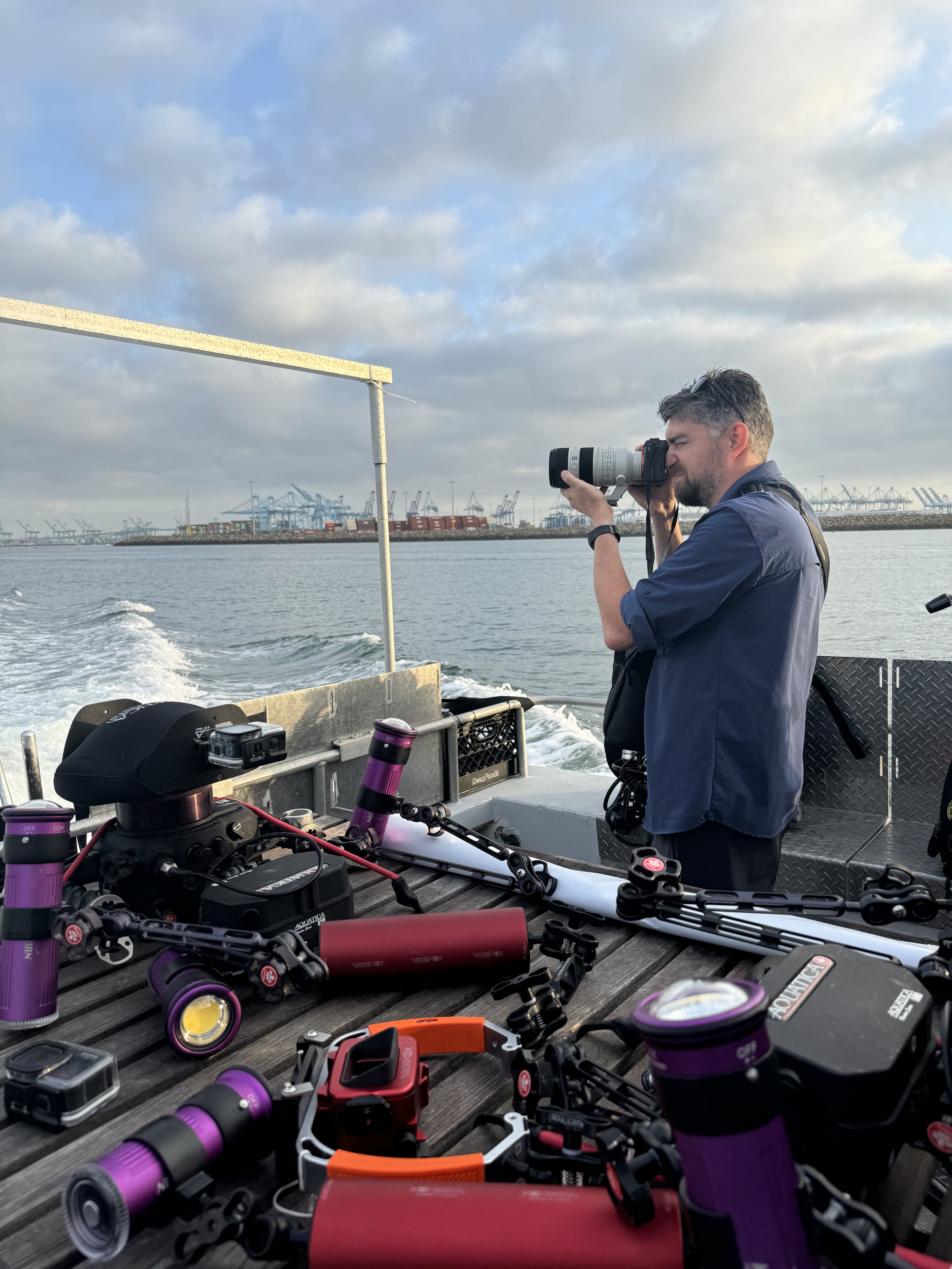
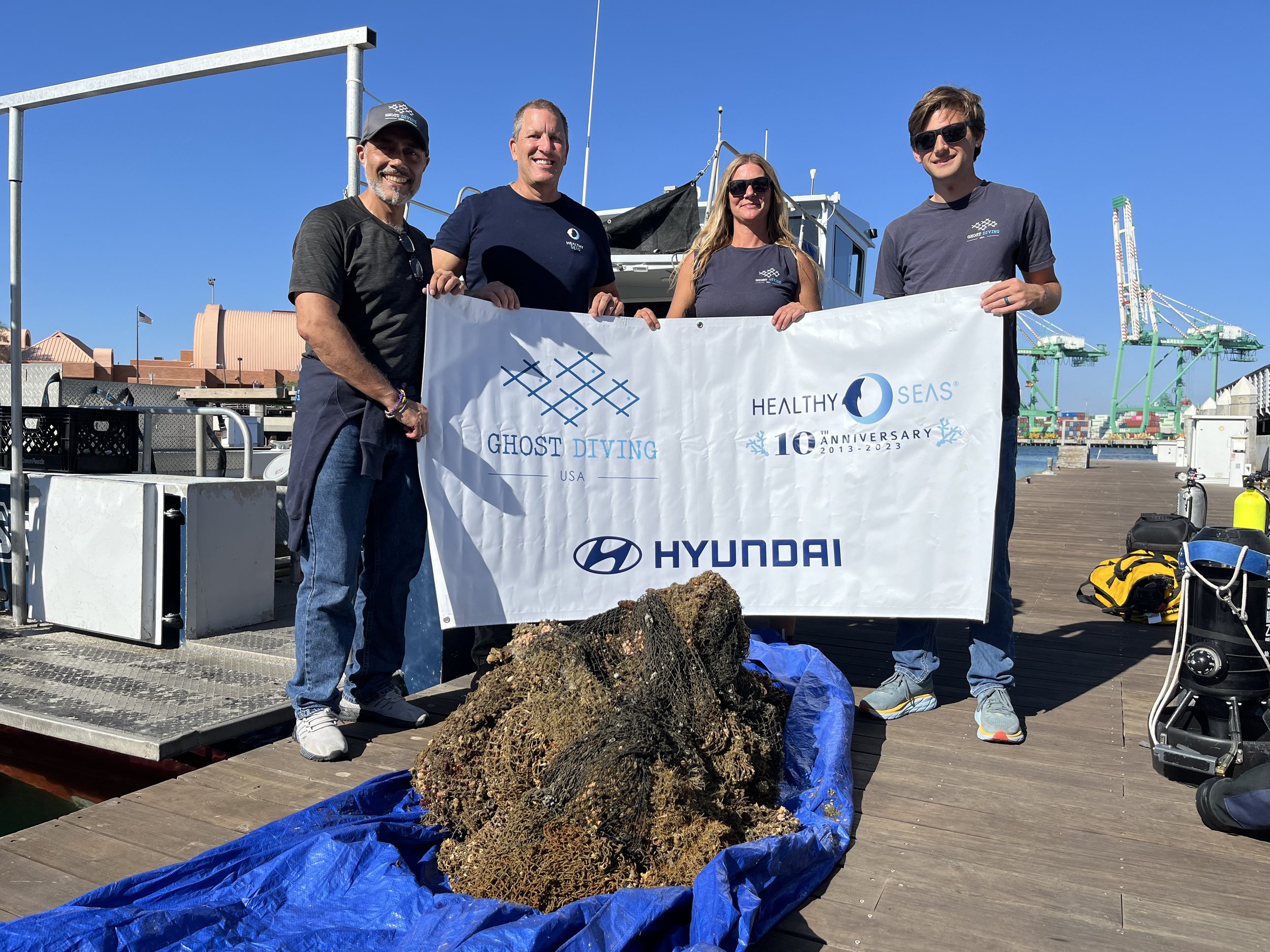
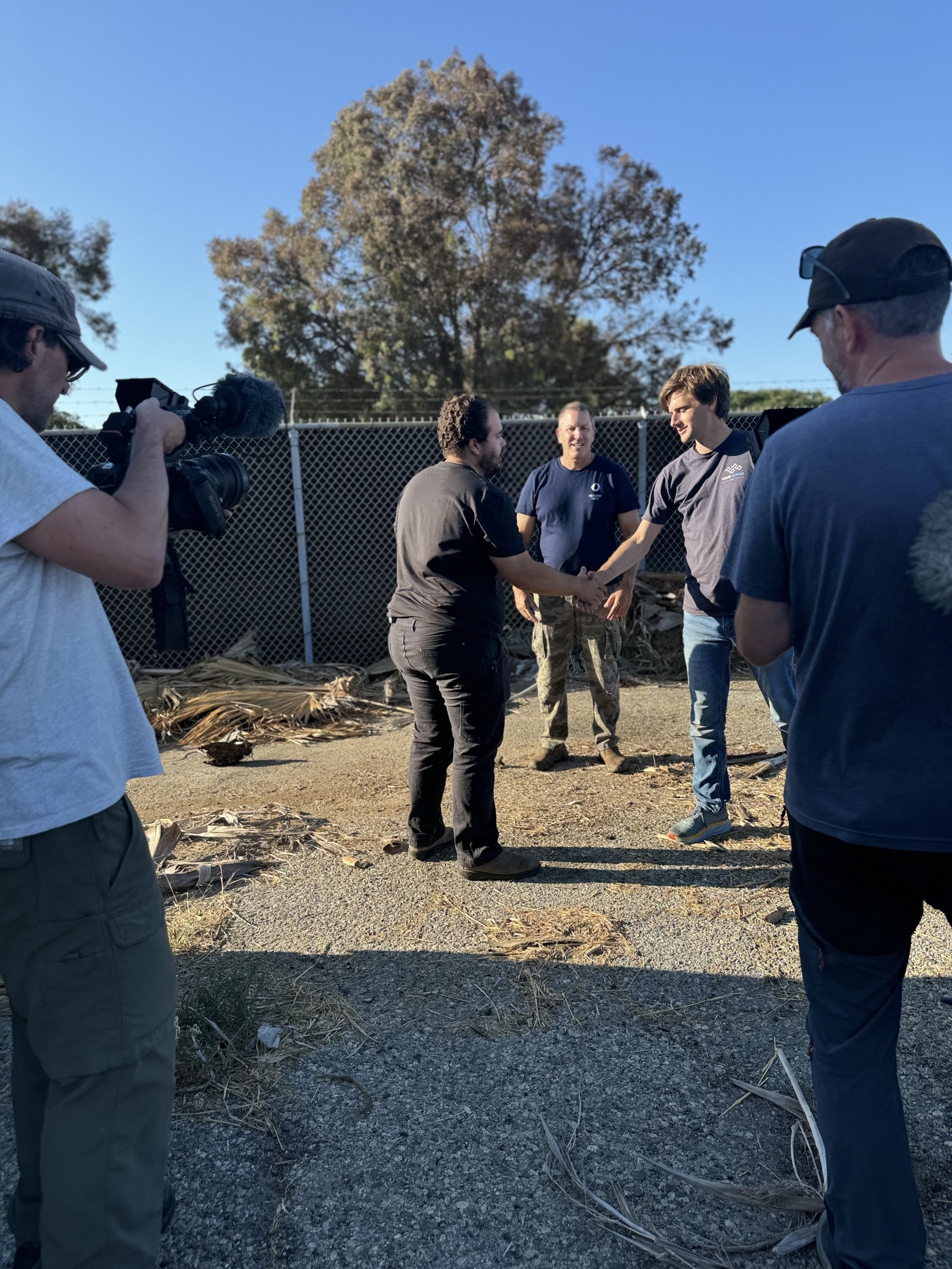
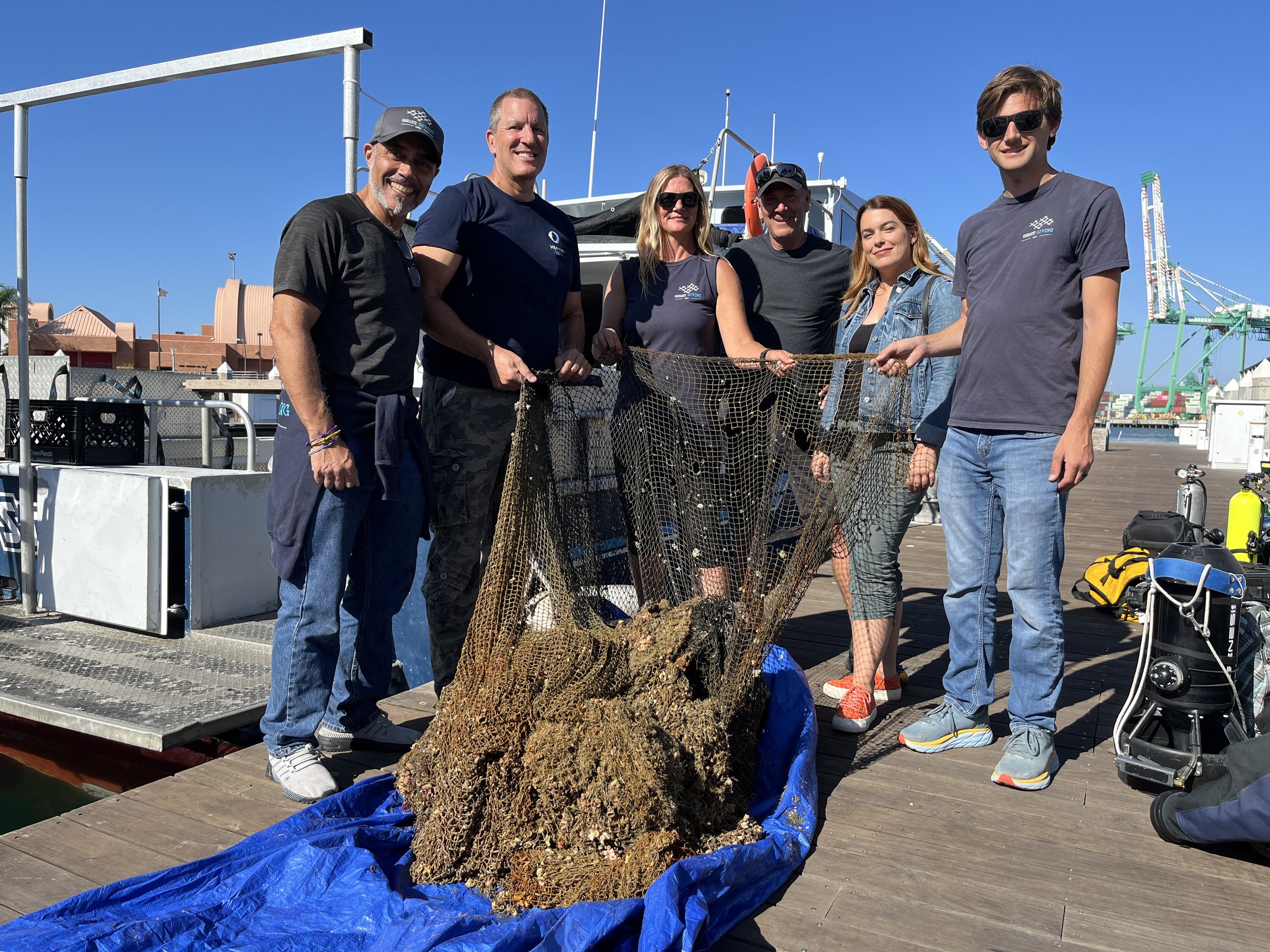
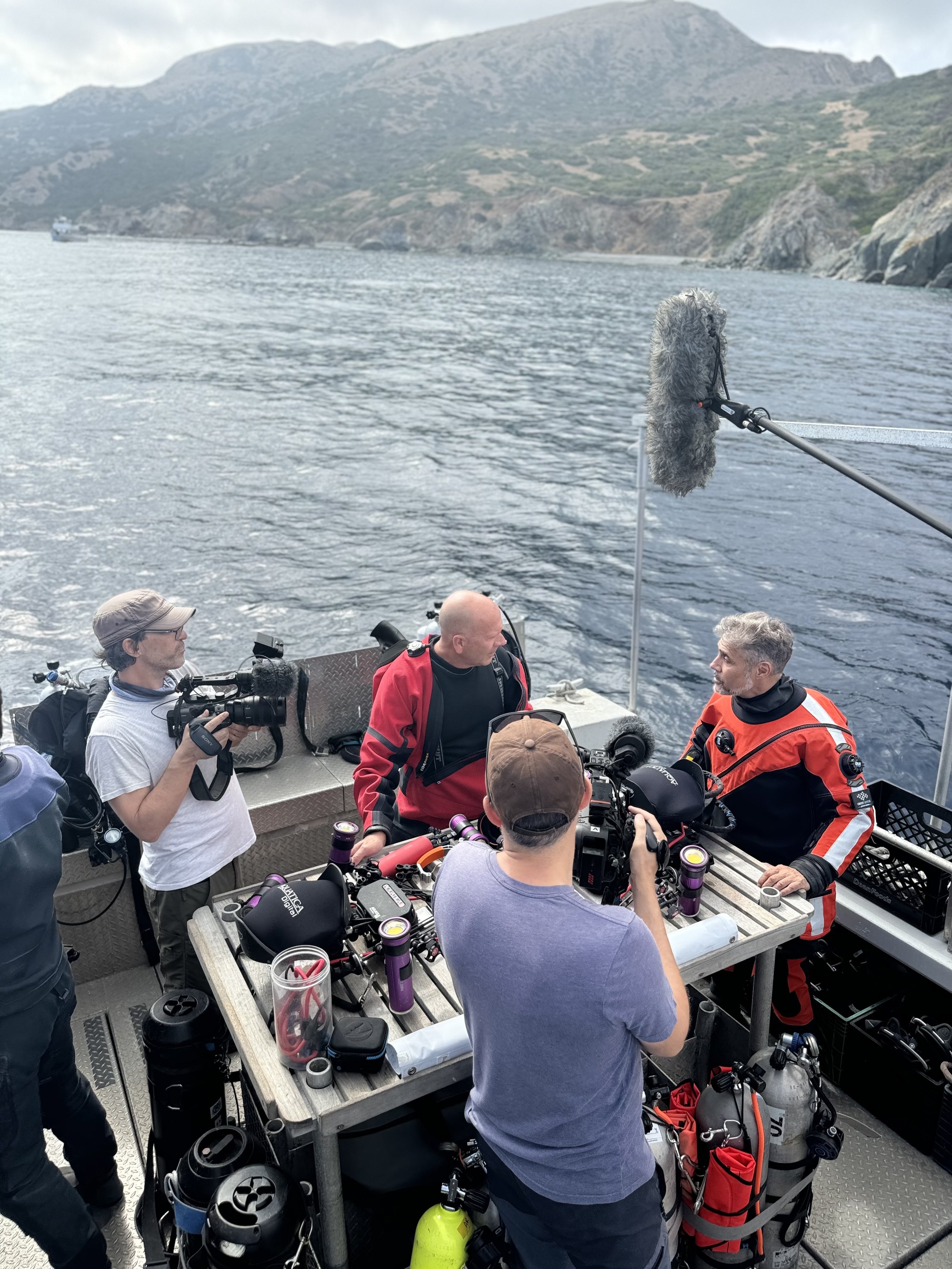
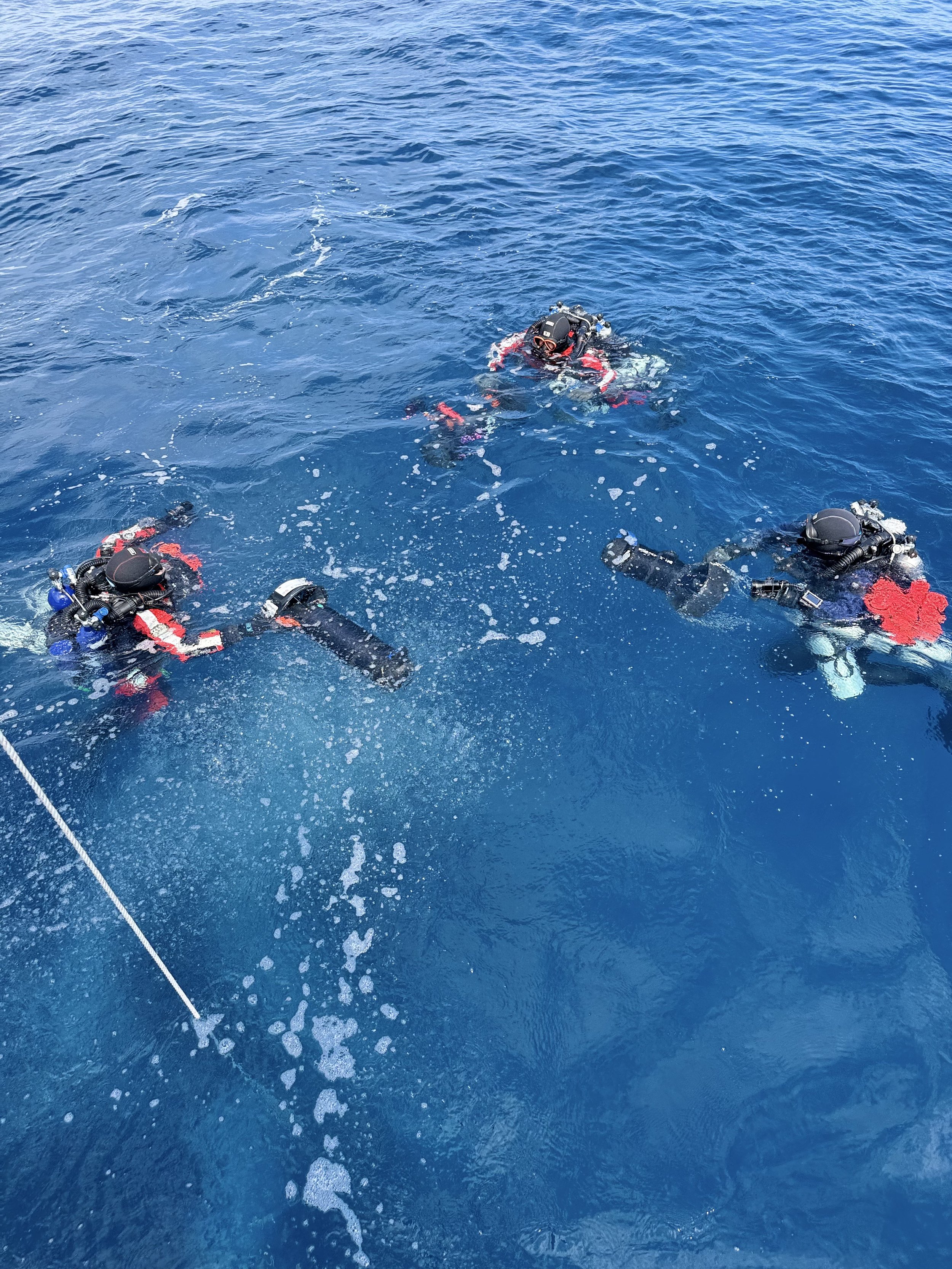

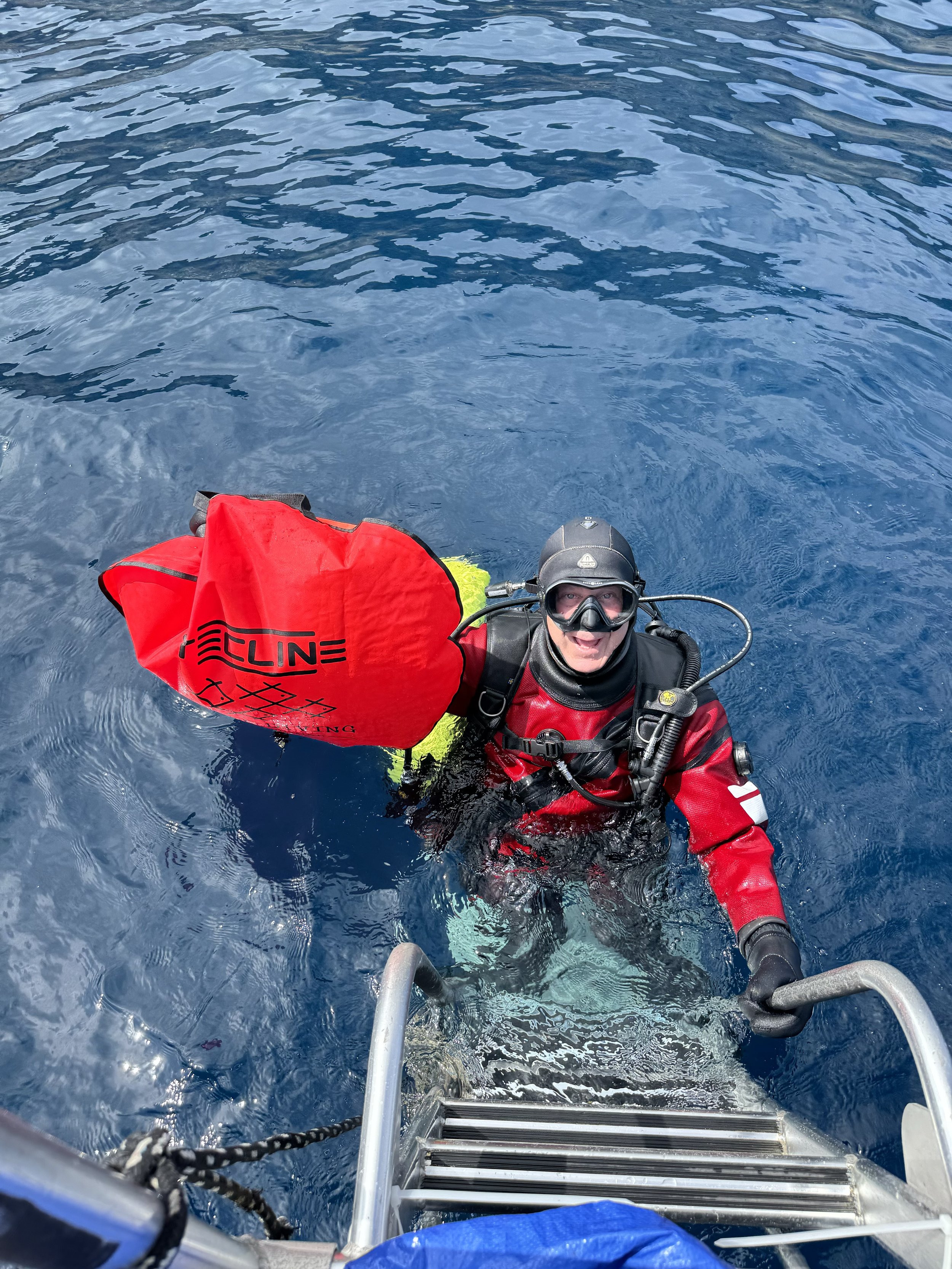
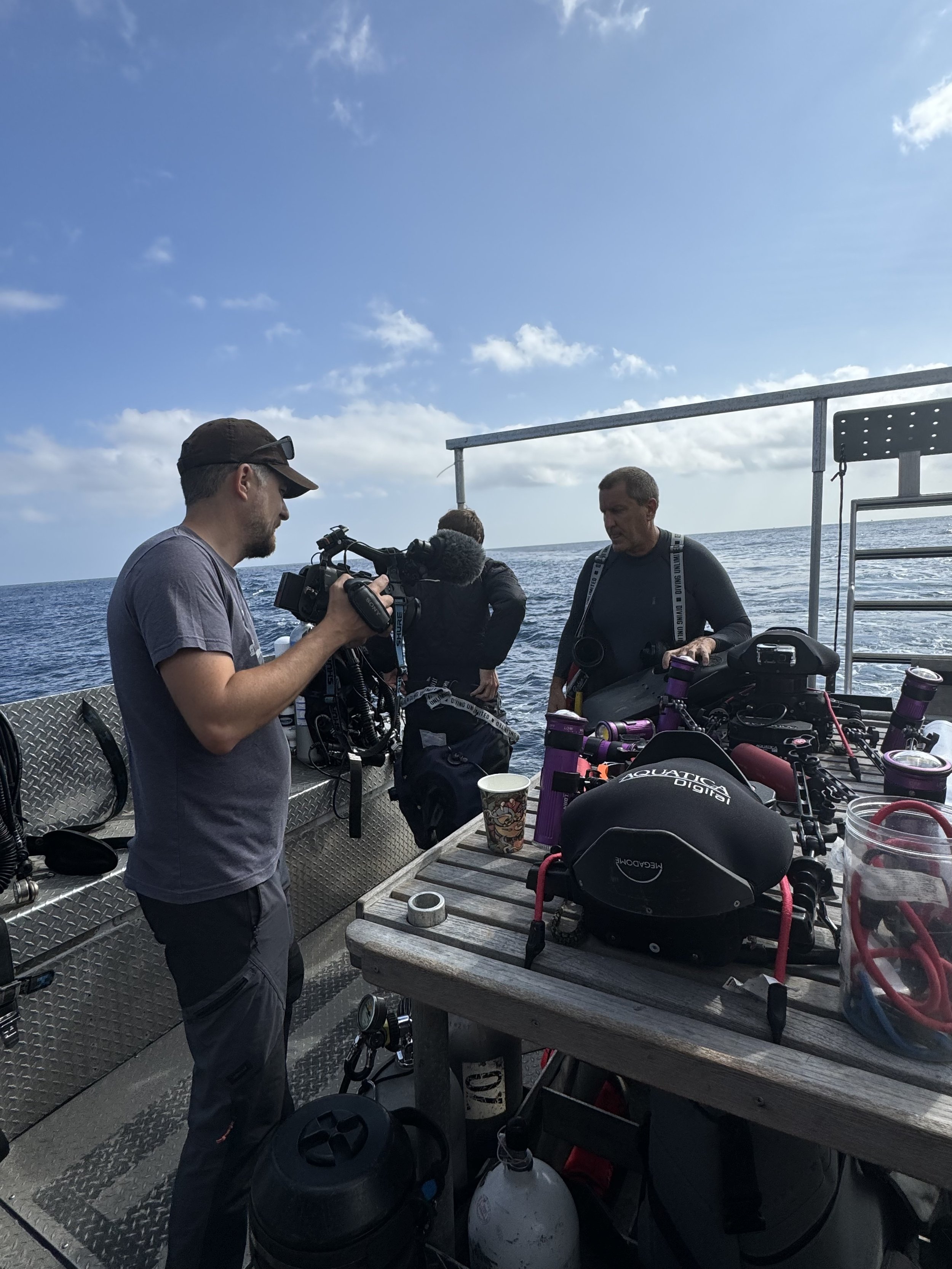
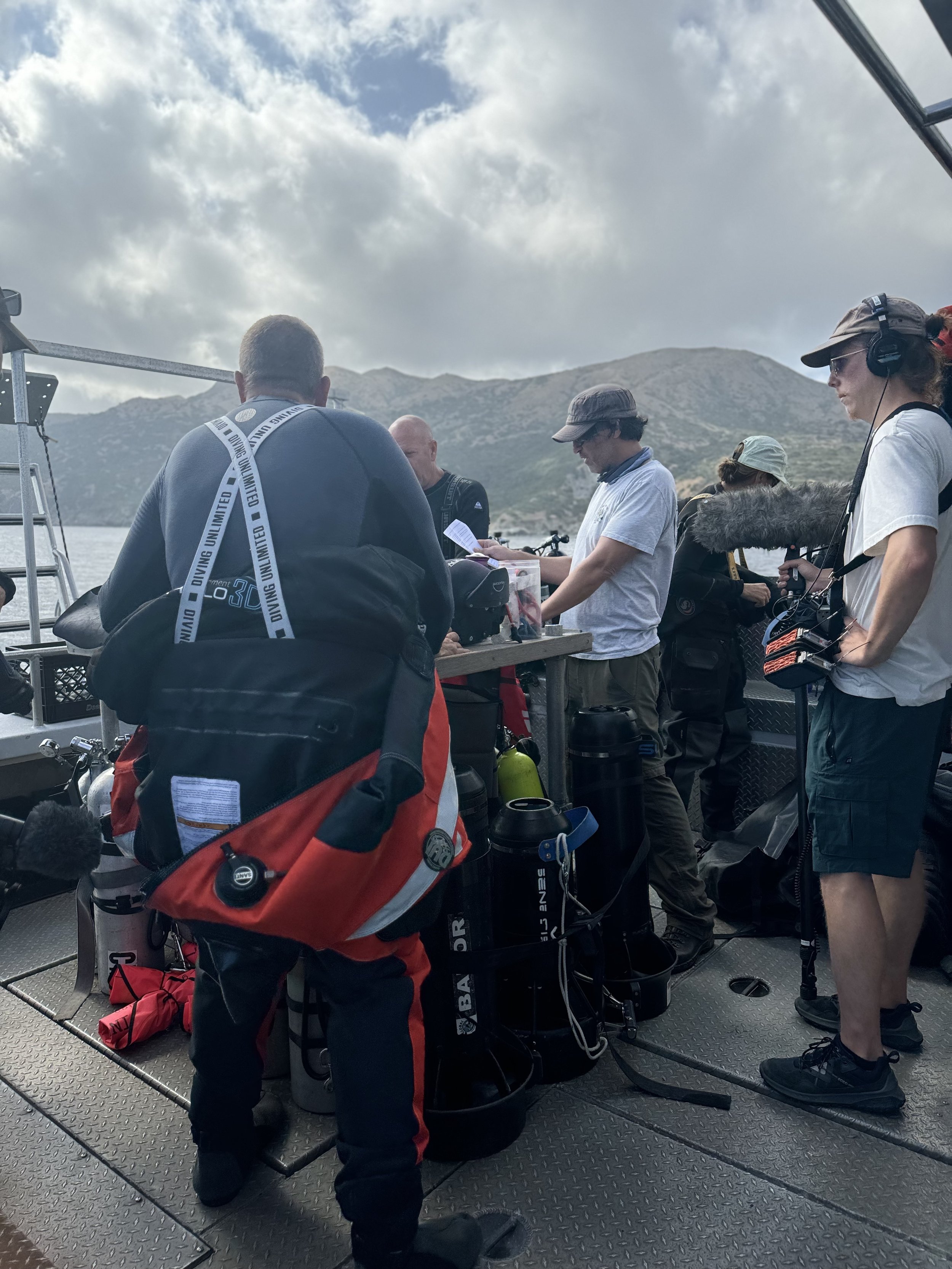
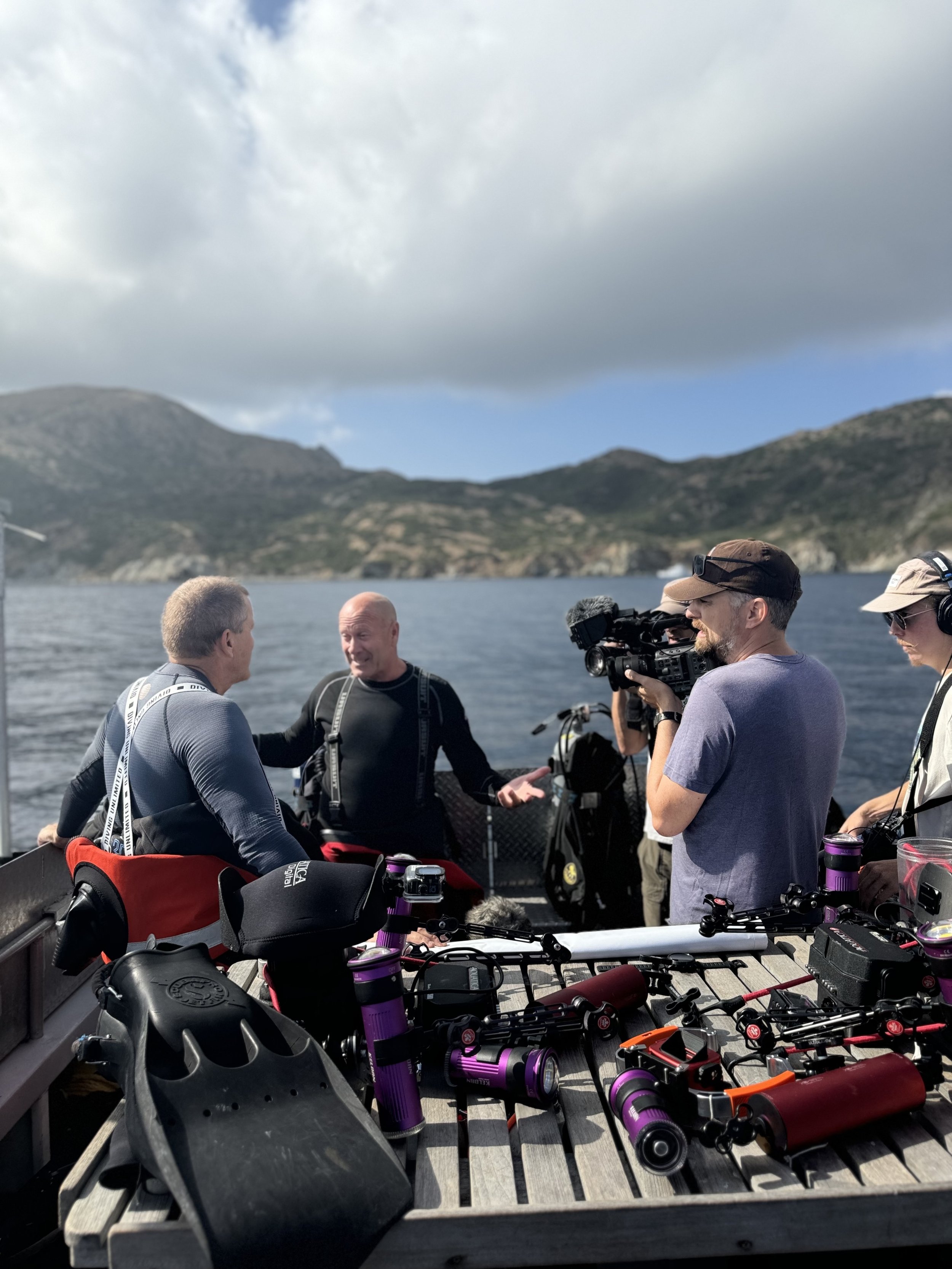
Location: Catalina Island, California
Wreck/Site: Tuna Clipper (San Vito)
Divers:
Team 1: Jim Babor, Karim Hamza, Curtis Wolfslau
Team 2: Mario Cyr and Stephanie
Surface Support: Angie Biggs
Mission Impact: 500 square feet of net removed, documentary footage captured
Team Ghost Diving USA is very excited to share that we were approached by a French-Canadian documentary team working with PVP Media regarding our work. Their goal was to collect information about unique diving professions as a part of an upcoming series and their research brought them to us!
Ghost Diving USA team members met up with the production crew at the dock for the Giant Stride. After a round of introductions, the teams immediately sprang into action and started conducting pre-interviews. They first inquired about our surface support team. Angie answered questions about her role on the mission, safety protocols, and her experience.
Next, the Ghost Diving and production teams boarded the Giant Stride and settled in for the day. The initial plan was to conduct pre-interviews with the team on the crossing over to Catalina Island. Unfortunately, due to wind noise, this was not an feasible option. The boat was stopped a little bit away from the site of the Tuna Clipper so the teams could film more content. After arriving at the site, the teams suited up and prepared to get into the water.
The Ghost Divers were treated to spending time in the water with renowned underwater cinematographer, Mario Cyr. Mario and his dive partner, Stephanie, went down the anchor line to approximately 60 feet. They waited for the Ghost Divers to descend and filmed their descent and took some more underwater shots.
Jim, Karim, and Curtis, upon reaching the wreck, conducted a survey of the wreck and worked to remove 2 sections of net near the harbor seal carcass that was found during last month’s mission. They then moved to the stern of the wreck and removed one more section of net. The divers completed their decompression obligation and enjoyed beautiful blue water and calm seas.
Once the divers got back to the surface, they discovered that Mario and Stephanie had jumped in to help retrieve the lift bags with nets and swam them back to the boat. With everyone back on board, the team set sail back to the mainland. During the crossing home, they were able to conduct additional interviews. Upon reaching shore, the team and production crew met Taylor Griffith at AltaSea to give him the nets that were collected today. The documentary team was able to film more footage and conduct additional interviews with Taylor. They were also able to tour different areas of AltaSea.
This day was rewarding and exciting for our team. We enjoy building connections and spreading the message of our work in unique and new ways. A very special thank you to PVP Media and the entirety of their team and especially Mario and Stephanie for jumping in and taking opportunities to participate in our mission.
An additional special thank you goes to Captain Jim Simmerman of The Giant Stride for helping us make this day possible
Alamitos Bay Yacht Club
Ghost Diving USA was invited to present at the Alamitos Bay Yacht Club in Long Beach, California. The meeting was well attended! We were happy to meet the members and see some familiar faces from the People Partners Foundation. The camaraderie amongst the yacht club members was palpable and gave a warm and inviting feeling to the meeting.
Jim, Katie, and Shane brought the recently 3D printed model of the UB-88 and discussed the upcoming project. While everyone in the room was very familiar with the area, some were unaware of the UB-88. It was really interesting to listen to the ensuing discussion. The members shared stories of animal encounters while sailing and seeing whales entangled in fishing gear. It was also interesting to hear the questions they had about our work.
Overall, the meeting was a great opportunity to connect with people that love the ocean and interact with it in a very different way than we do.
